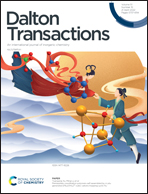Visible and near-infrared emitting heterotrimetallic lanthanide–aluminum–sodium 12-metallacrown-4 compounds: discrete monomers and dimers†
Abstract
The luminescence properties of two types of heterotrimetallic aluminum–lanthanide–sodium 12-metallacrown-4 compounds are presented here, LnNa(ben)4[12-MCAl(III)N(shi)-4] (LnAl4Na) and {LnNa[12-MCAl(III)N(shi)-4]}2(iph)4 (Ln2Al8Na2), where Ln = GdIII, TbIII, ErIII, and YbIII, MC is metallacrown, ben− is benzoate, shi3− is salicylhydroximate, and iph2− is isophthalate. The aluminum–lanthanide–sodium metallacrowns formed with benzoate are discrete monomers while, upon replacement of the benzoate with the dicarboxylate isophthalate, two individual metallacrowns can be joined to form a dimer. In the solid state, the terbium version of each structure type displays emission in the visible region, and the erbium and ytterbium complexes emit in the near-infrared. The luminescence lifetimes (τobs) and quantum yields have been collected under ligand excitation (QLLn) for both LnAl4Na monomers and Ln2Al8Na2 dimers. Several of these values tend to be shorter (luminescence lifetimes) and smaller (quantum yields) than the corresponding values recorded for the structurally similar gallium–lanthanide monomer and dimer 12-MC-4 molecules. However, the quantum yield value recorded for the visible emitting Tb2Al8Na2 dimer, 43.9%, is the highest value observed in the solid state to date for a TbIII based metallacrown.



 Please wait while we load your content...
Please wait while we load your content...